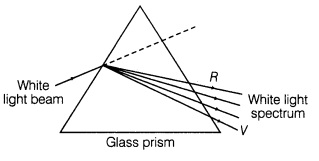1. Ray Optics or Geometrical Optics In this optics, the light is considered as a ray which travels in a
straight line. It states that for each and every object, there is an image.
2. Reflection Reflection is the phenomenon of changing the path of light without any change in the medium.
3. Reflection of Light The returning back of light in the same medium from which it has come after striking a surface is called reflection of light.
4. Laws of Reflection
Two laws of reflection are given as below:
(i) The angle of incidence i is equal to the angle of reflection r.
i.e. ∠i = ∠r.
(ii) The incident ray, reflected ray and normal to the reflecting surface at the point of incidence all lie in the same plane.
(i) The angle of incidence i is equal to the angle of reflection r.
i.e. ∠i = ∠r.
(ii) The incident ray, reflected ray and normal to the reflecting surface at the point of incidence all lie in the same plane.
5. Total
number of images formed by two plane mirrors inclined at an angle θ with each
other is given by
6. Reflecting surface of a spherical mirror is a part of a hollow sphere. Spherical mirrors
are of two types, (i) Concave spherical mirror (ii) Convex spherical mirror.
7. Sign Convention All measurements should be taken from pole of mirror. All
measurements along the direction of incident ray will be positive and opposite
to incident ray are negative. All the measurements for the distances above the
principal axis are taken as positive and below the principal axis are taken as
negative.
8. For
a real object, u is negative whereas v is negative for real image and positive
for virtual image.9. Mirror Formula Mirror formula is a relation between focal length of the mirror and distances of objects and image from the mirror.
11. Linear Magnification The ratio of the size of the image formed by a spherical mirror I to
the size of the object O is called the linear magnification produced by the
spherical mirror.
12. Magnification (m) It is negative corresponding to real image and positive for
virtual image.
13. Refraction The phenomenon of changing in the path of light as it goes from one medium to another is called refraction.
14. Laws of Refraction
Two laws of refraction are given as below:
(i) The incident ray, refracted ray and the normal to the refracting surface at the point of incidence lie in the same plane.
(ii) The ratio of the sine of the angle of incidence to the sine of the angle of refraction is constant for the two given media. This constant is denoted by n and is called the relative refractive index.
n = sin i/sin r (Snell’s law)
where, n is refractive index of the second medium when first medium is air.
(i) The incident ray, refracted ray and the normal to the refracting surface at the point of incidence lie in the same plane.
(ii) The ratio of the sine of the angle of incidence to the sine of the angle of refraction is constant for the two given media. This constant is denoted by n and is called the relative refractive index.
n = sin i/sin r (Snell’s law)
where, n is refractive index of the second medium when first medium is air.
17. Total Internal Reflection (TIR) When a ray of light travelling from denser medium to rarer
medium is incident at the interface of two medium at an angle greater than the
critical angle for the two media, the ray is totally reflected back to denser
medium. This phenomenon is called Total Internal Reflection. It occurs only
when angle of incidence in denser medium is greater (not equal) than critical
angle, i.e. i> ic.
18. Principle of reversibility of light states that when final path of a ray of light after any
number of reflections and refractions is reversed, the ray retraces its entire
path.
22. Optical
fibre, mirage, sparkling of diamond, totally reflecting prism, etc. work on the
principle of total internal reflection.
24. Lens is a transparent medium bounded by two surfaces of which one or both
surfaces are spherical.
(i) Convex or Converging Lens A lens which is thicker at the centre and thinner at its end is called convex lens.
Convex lenses are of three types which are given as below:
(ii) Concave or Diverging Lens A lens which is thinner at the centre and thicker at its ends is
called a concave lens.
Concave lenses are of three types which are given as below:
Concave lenses are of three types which are given as below:
26. When
lens of refractive index μ is immersed in a medium of refractive index μ, then
(i) When lens is taken in another medium, then focal length changes to fm which is given by
(i) When lens is taken in another medium, then focal length changes to fm which is given by
28. Power of Lens The ability of a lens to converge or diverge the rays of light
incident on it is called the power of the lens.
29. Power
of combination lenses in contact is given by
30. Magnification
by combination of lenses
m = m1 × m2 × m3 ………..
m = m1 × m2 × m3 ………..
31. (i) Prism have got the property of bending the incident light
towards its base.
A prism is a portion of a transparent medium bounded by two plane faces inclined to each other at a suitable angle.
A prism is a portion of a transparent medium bounded by two plane faces inclined to each other at a suitable angle.
Dispersive Power Dispersive power of a prism is defined as the ratio of
angular dispersion to the mean deviation produced by the prism.
33. Combining
two thin prisms we can study two conditions






















